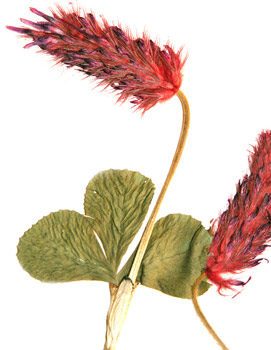Relatives
Trifolium incarnatum L. - Crimson clover.
Taxonomic position.
Family Leguminosae Endl., genus Trifolium L.Synonyms.
Trifolium incarnatum var. elatius Gibelli et Belli, T. incarnatum var. sativum Ducommun, Т. incarnatum subsp. incarnatum Coombe.Italian clover, French clover, Scarlet Clover, Carnation Clover.
Biology and morphology.
Pubescent annual. Tap-rooted with many finely-branched lateral roots. Semi-erect to erect growing plant with a crown rosette of very hairy stems, 30-60 cm, which have few side branches. Leaves broad and round- tipped; stipules rounded with purple edging developing with age. Inflorescences are terminal conical racemes up to 6 cm long and 1,0 to 2,5 cm wide.and some distance above last stem leaf. Florets, 75-125 in number, 10 to 15 mm long, usually scarlet to red, infrequently yellowish-white. Calyx about 1,0 cm long, the tube cylindrical with appressed long hairs, ten-veined, the teeth linear, almost equal, sharp-pointed, densely long hairy. Corolla with standard much longer than the wings and keel. Pods ovoid 1-seeded, papery with leathery apex. Seeds oval to spherical, 2,5 mm long, and cream to light brown in colour. Flowering period is from May to August. Self-fertile plant but mostly cross-pollinated by bumble bees and bees. 2n = 14.Distribution.
The Mediterranean is the center of diversity for species. Grown here and there at the European part of former USSR (especially Leningrad region and Ukraine) and at the Caucasus and runs wild.Ecology.
Meadows and roadsides, fields, pastures. Adapted to a wide range of soil and climatic conditions. Not tolerant of shade. Poor tolerance to drought and flooding and to poorly-drained or saline soils.Utilization and economic value.
Good compatibility with grasses and legumes. Suitable for hay and silage. Highly acceptable forage for grazing, silage or hay (though not at mature hay stage). Protein-rich forage especially at leafy growth stage. Poor regrowth after grazing. Calyces are covered with stiff hairs which may cause digestive upsets if sward grazed during flowering. Hay cut at mature stage of growth can be harmful to livestock since hairs of stems and flower heads have become hard and tough. Perspective for sprigging of dry meadows and slopes with truncated soils. Can also be used as a summer annual for green manure in cooler northern latitudes.Literature:
Brezhnev D. D., Korovina O. N. 1980. Wild relatives of the cultivated plants of flora of the USSR. - L.: Kolos, 376 pp. (in Russian).Flora of cultivated plants. Trifolium, Lotus. 1993. Mukhina N. A., A. K. Stankevich (ed.). - M..: Kolos, Vol. XIII. - 334 pp. (in Russin).
Flora of the European part of the USSR. 1987. Phyodorov A. A. (ed.). Vol. VI. - 254 pp. (in Russian).
Flora of the USSR, 1945. Schischkin V.K., E.G. Bobrov (ed.). Vol. 11, M.-L.: AN USSR , p. 129 - 176. (in Russian).
Galushko A. I. 1980. Flora of Northern Caucasus. A field guide. - Rostov - na - Donu:, Vol. 2. - 350 pp. (in Russian).
Grossheim A. A. 1952. Genus Trifolium. Flora of the Caucasus. M.-L.: AN USSR, v.5 - p. 191 - 221. (in Russian).
Kolakovskiy A. L. 1958. Flora of Abhasiya. - Tbilisi:, Vol. 3. - 292 pp. (in Russian).


